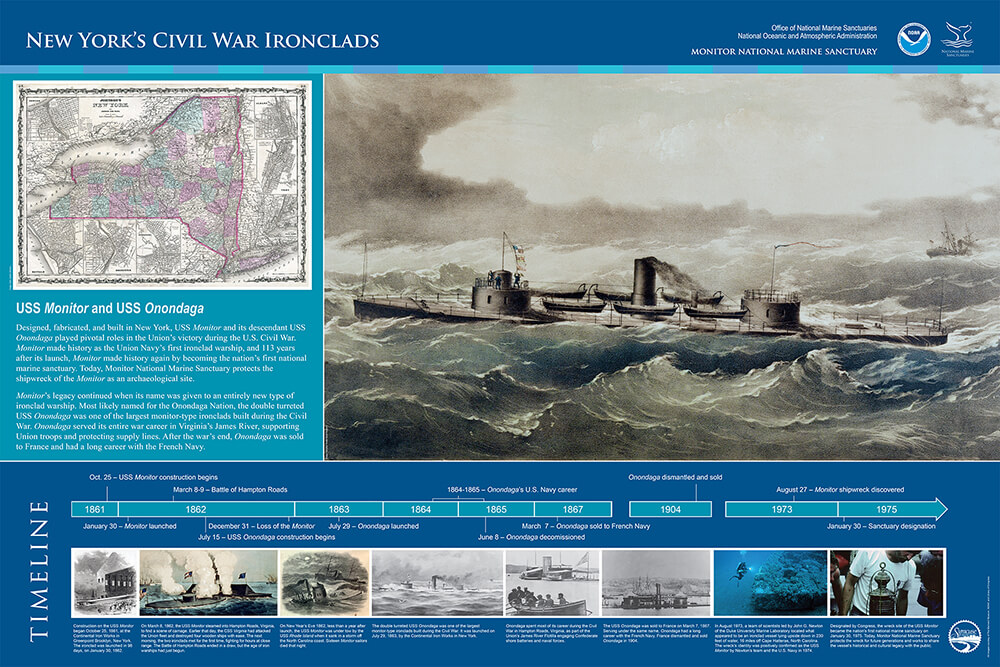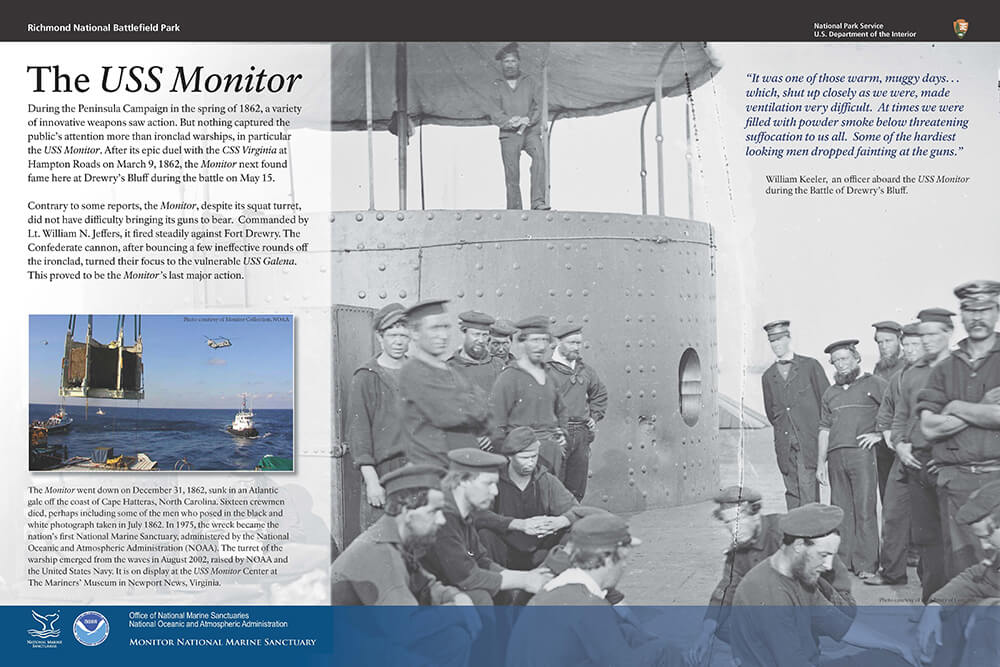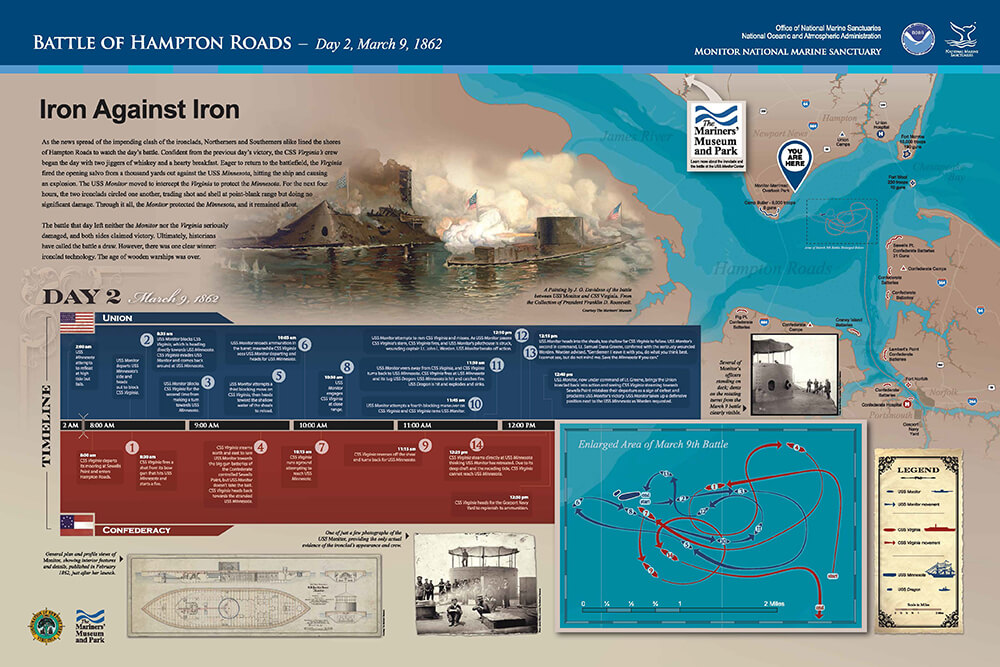Places to Go
USS Monitor sank on December 31, 1862, and became the nation's first national marine sanctuary in 1975. Although Monitor's wreck site is located in 230 feet of water 16 miles off the North Carolina coast, its story is truly a national one. From the upper reaches of New York, down the East Coast, and across the country to Arches National Park in Utah, USS Monitor is honored and memorialized. In addition to the many partner exhibits located in Virginia and North Carolina, you can also discover an array of immersive experiences both in person and online to learn about USS Monitor and our nation's maritime heritage off coastal North Carolina.
Virtually Explore North Carolina's Outer Banks
Surrounded by water, the Outer Banks of North Carolina are a chain of narrow barrier islands separating the Currituck, Albemarle, and Pamlico sounds from the Atlantic Ocean. This dynamic environment has shaped the islands and its people for centuries.
No matter if you are physically visiting the Outer Banks or exploring online from your living room, we invite you to explore our Outer Banks Maritime Heritage Trail. Here you will find videos and oral histories that take you along Highway 12 to learn more about the many iconic places and features that make this area unique. From the lighthouses to the wildlife to the shipwrecks offshore, the Outer Banks culture reflects the surrounding marine environment.
Downloadable video files and captioned versions
Education Activities
If you are a teacher, check out these educational activities for the Outer Bank Maritime Heritage Trail. Students experience the unique maritime culture of the Outer Banks, as they watch one or all eleven video clips and listen to the oral histories of those who experienced World War II on the shores of the Outer Banks. Each video and oral history is accompanied by supporting activities and a set of focus questions, to be answered while the students view the video or listen to the oral histories.
Download the educational activity packet
Along the East Coast: Monitor Trail Signs
From its conception to construction, from the battle to sinking, and from discovery to recovery and conservation, the Civil War ironclad USS Monitor is truly a revolutionary vessel.
Today, a series of trail signs dot the landscape along the East Coast from New York to North Carolina telling Monitor's story. Find the location of these trail signs and learn more about the history of the USS Monitor, its crew, and all those who work to honor and protect it today.
Trail Signs
Syracuse, New York
After the construction of the USS Monitor, other turreted ships were produced. One such ship was the double turreted monitor-type ironclad, USS Onondaga. Built at the Continental Ironworks in Greenpoint, New York, Onondaga was named by U.S. Representative Charles Baldwin Sedgwich of Syracuse, New York.

Greenpoint, Brooklyn, New York
In 1859, Thomas Fitch Rowland established the Continental Iron Works at this site in Greenpoint, Brooklyn, New York. When the Civil War began, the company was engaged by John Ericsson to build a “shot-proof steam battery.” On October 25, 1861, the keel for the ironclad was laid and construction began on the ship that Ericsson named Monitor. Just 98 days later, Monitor launched on January 30, 1862.

Wilmington, Delaware
Wilmington's Civil War Ironclads
Established in 1836, the Wilmington manufacturing firm of Harlan & Hollingsworth led the nation in the construction of iron-hulled ships prior to the Civil War and pioneered many iron fabrications and shipbuilding techniques. When the U.S. Navy suddenly needed fleets of new ironclad warships to combat the Confederacy during the Civil War, it was no surprise they called on Harlan & Hollingsworth. Three monitor-type warships were built there, the USS Patapsco, USS Saugus, and USS Napa.

USS Monitor – America's First National Marine Sanctuary
Designed by John Ericsson, the USS Monitor launched on January 30, 1862, at the Continental Iron Works in Greenpoint, New York. USS Monitor made history as the Union Navy's first ironclad warship with a rotating gun turret. One hundred and thirteen years after its launch, Monitor made history again by becoming the nation's first national marine sanctuary.

Drewry's Bluff, Virginia
During the Peninsula Campaign in the spring of 1862, a variety of innovative weapons saw action. But nothing captured the public's attention more than the ironclad warships, in particular the USS Monitor. After its epic duel with the CSS Virginia at Hampton Roads on March 9, 1862, Monitor next found fame at Drewry's Bluff during the battle on May 15.

Newport News, Virginia
- Overlook Park
- Day 1: The CSS Virginia was slow and unwieldy, but this Confederate ironclad had one of the most destructive maiden voyages in history. In less than eight hours, Virginia attacked the entire Union fleet in Hampton Roads, sinking four vessels, capturing a transport, and damaging four other warships.

- Day 2: As the news spread of the impending clash of ironclads, northerners and southerners alike lined the shores of Hampton Roads to watch the March 9, 1862 battle. The battle that day left neither Monitor nor Virginia seriously damaged. Both sides claimed victory, and historians called the battle a draw, but one clear winner was ironclad technology.
- USS Monitor, America's first national marine sanctuary. The shipwreck of the USS Monitor, located off the North Carolina coast, is both an important archaeological site as well as a vibrant artificial reef providing habitat for hundreds of species of fish and other marine animals.


- Day 1: The CSS Virginia was slow and unwieldy, but this Confederate ironclad had one of the most destructive maiden voyages in history. In less than eight hours, Virginia attacked the entire Union fleet in Hampton Roads, sinking four vessels, capturing a transport, and damaging four other warships.
- The Mariners' Museum and Park: In 1987, NOAA selected The Mariners' Museum as the principal repository for the conservation and preservation of USS Monitor artifacts. The museum's state-of-the-art Batten Conservation Laboratory Complex, where thousands of Monitor artifacts are conserved, opened in 2006. In 2007, in partnership with NOAA, the museum opened the USS Monitor Center where visitors of all ages can learn the complete story of the USS Monitor.

Virginia Beach Surf & Rescue Museum
More than any other place in the United States, coastal Virginia and North Carolina serve as a uniquely accessible underwater museum and memorial to World War II's Battle of the Atlantic. Monitor National Marine Sanctuary and partners have documented and surveyed the unique collection of World War II Allied and German vessels.

Beaufort, North Carolina
In August 1973, John G. Newton of the Duke University Marine Lab in Beaufort, North Carolina, led an interdisciplinary team of distinguished scientists in search of the USS Monitor. In 1974, it was confirmed that they had indeed found the USS Monitor.


